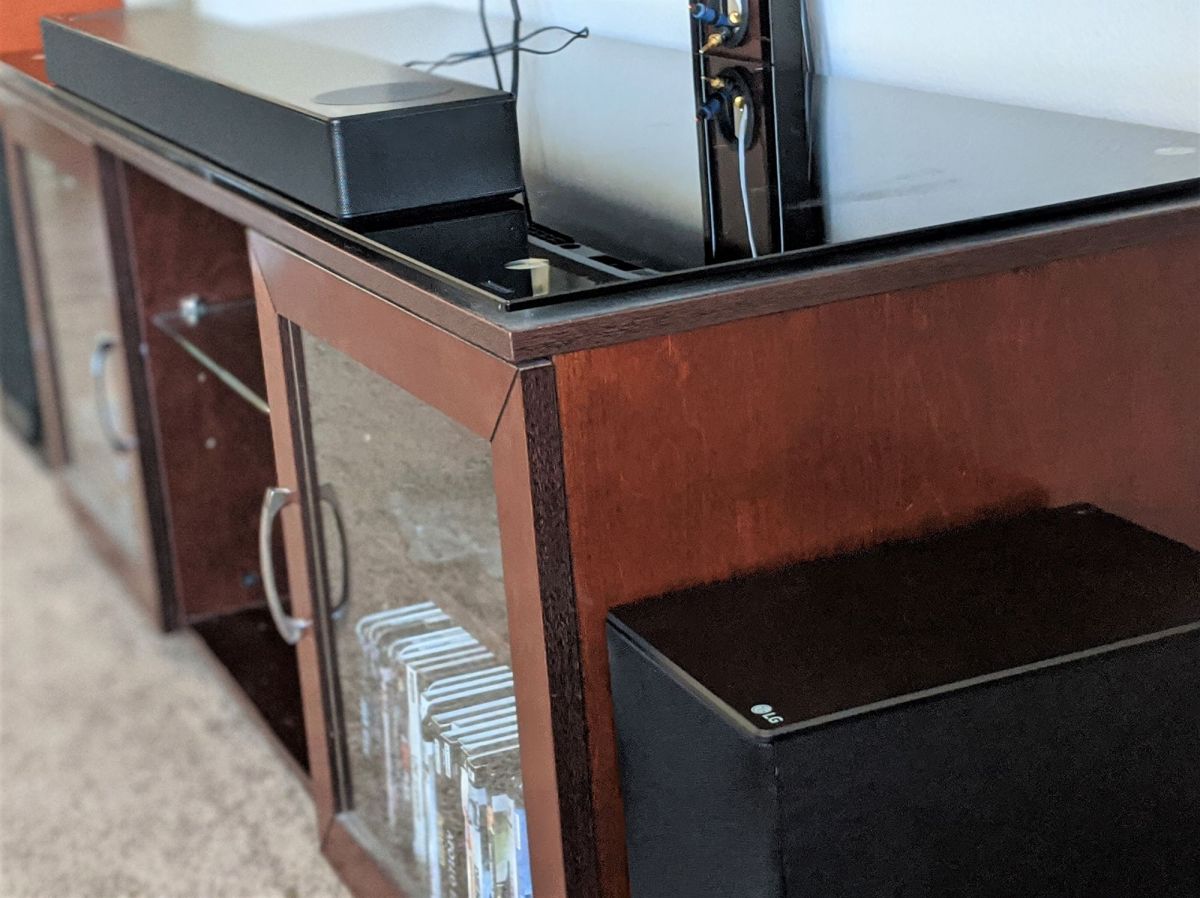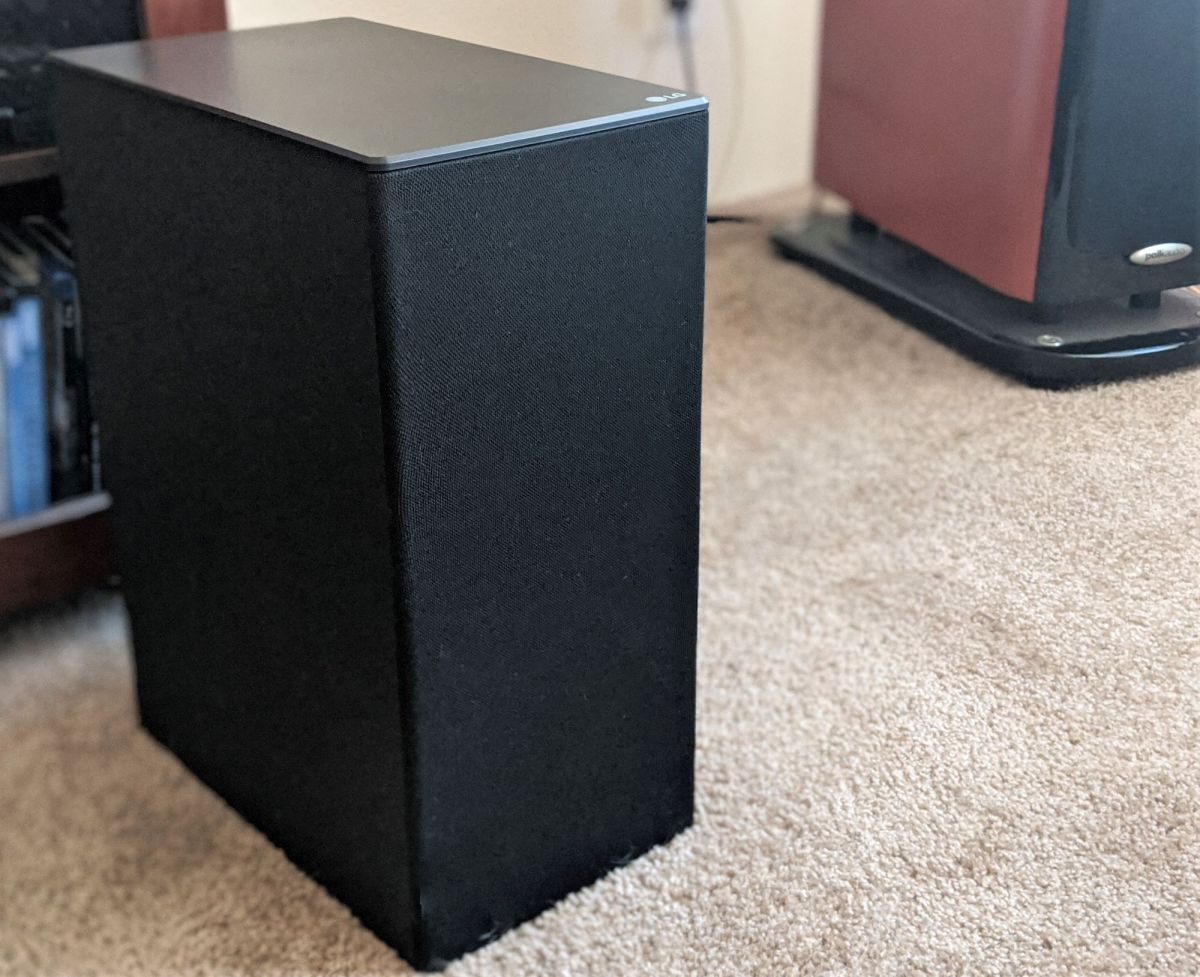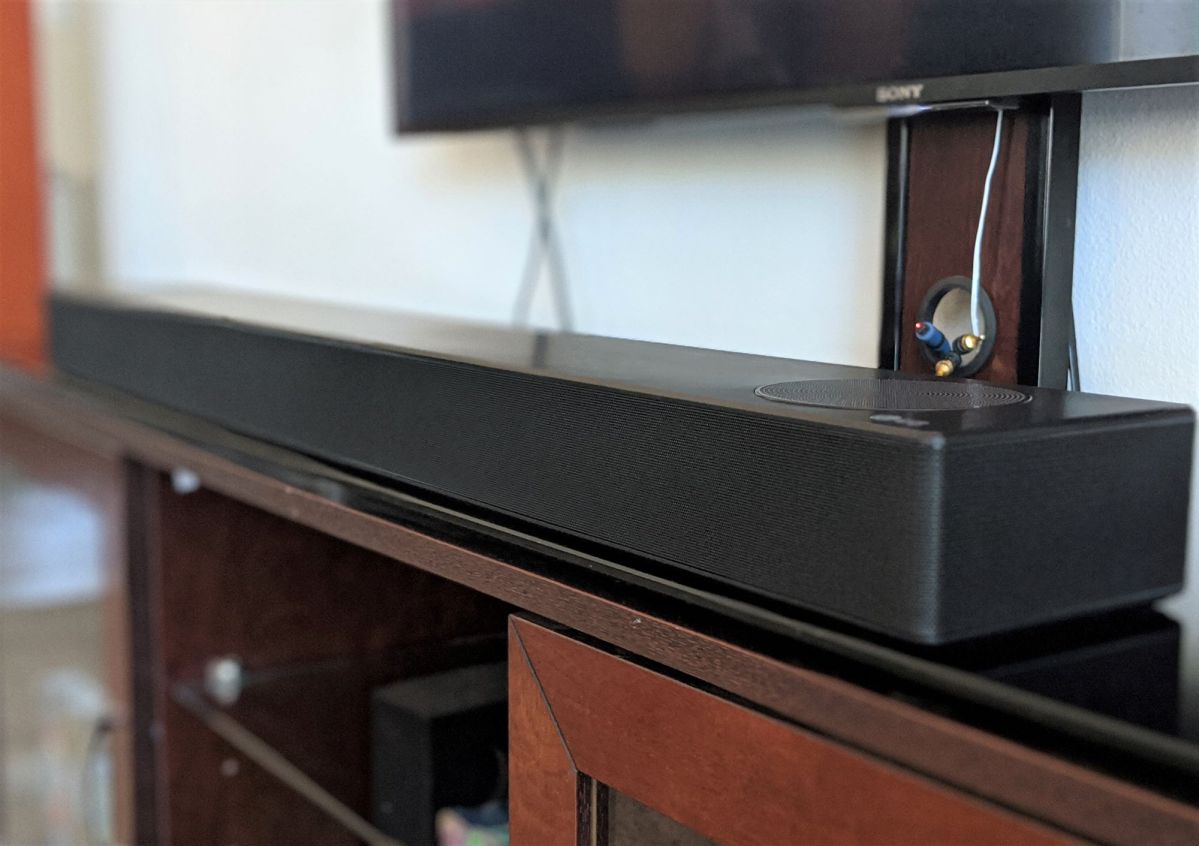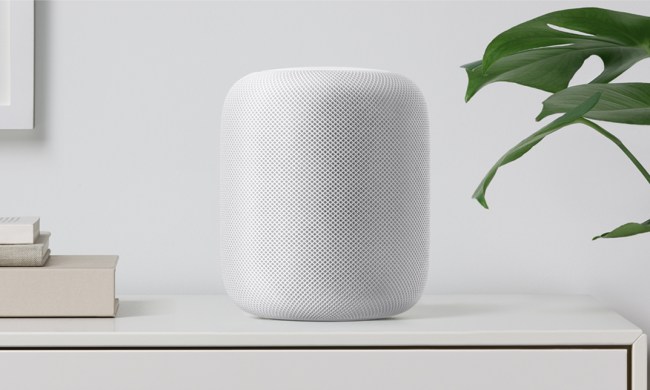- Sleek design
- Simple setup
- Solid overall sound quality
- Impressive Dolby Atmos
- Lacks Wi-FI
- Average bass
Of all the soundbars in LG’s 2020 lineup, the SN7Y might just be the most intriguing. It’s a 3.1.2-channel soundbar system with support for a wide variety of audio formats – Dolby Atmos and DTS:X chief among them – that carries a far cheaper entry fee than the company’s flagship models.
The system lacks rear speakers for true surround sound, and faces steep competition from the likes of Samsung, Vizio, and Sony. After spending a significant amount of time with this bar, though, one thing is clear: Without a doubt, the $500 SN7Y deserves a seat at the table of budget Atmos soundbars.
Design
Having reviewed LG’s top-of-the-line SN11RG well before receiving the SN7Y, the similarities between the two ends of the spectrum are hard to overlook. One is far bigger, of course; the SN11RG is 57 inches wide, compared to the 35-inch long SN7Y, which falls closely in line with competitors like the Sony HT-G700 (38.58 inches). Otherwise, the SN7Y is a miniature version of its more expensive relative design-wise, with a sleek finish that resembles a much more expensive product.

The bar itself contains drivers for the front left, center, and right channels, as well as a pair of upfiring speakers to provide the height channels of the 3.1.2 system. LG has once again been light on details about the actual drivers, other than the fact that they’re each being driven by 30 watts of power, with the heights getting 35 watts each. That doesn’t mean much, unfortunately.
The included wireless subwoofer is rear-ported and weighs in around 17 pounds. Again, that’s close by comparison to the Sony’s 16-pound wireless woofer. There are no rear speakers included in this setup, which is something of a disappointment when you can get a full 5.1.2 setup from Vizio for the same price. You can opt for purchasing LG’s rear speaker kit to complete the system, but we’re talking about another $180.
The remote is almost identical to the same accessory that accompanies the SN11RG, except for a Google Assistant button that’s missing on the remote for the SN7Y. That’s because this bar doesn’t have Wi-Fi, a sad fact that we’ll touch on later.
Setup
Possibly the only benefit in not having rear speakers or Wi-Fi is the added simplicity of setting this system up. There are no wires to connect between rear speakers and subwoofers like there are in a traditional Vizio system, and no app to download and configure the soundbar’s settings as you’d find in a product like the Sonos Beam. With the SN7Y, it’s much more streamlined.

The soundbar needs power, and so does the subwoofer. Once they’re powered on, they’ll wirelessly pair with each other, as has become standard with most wireless sub setups. The soundbar will need to be connected to your display, of course, and I’ll touch on the different types of connections offered by this bar in a moment. But once that connection is made, you’re free to begin enjoying the system.
With no rear speakers to worry about, you’re free to place your subwoofer wherever you want in your space. It’s no secret that subwoofers will have different responses based on where they’re placed it in a room but wired rear speaker setups always limit where your woofer can be. Without rears, and even if you opt for the wireless rear kit, LG puts you in the driver’s seat in attempting to determine the best placement for your sub.
Connections
The LG SN7Y has one HDMI HDCP 2.3 input, and a corresponding HDMI output capable of 4K, Dolby Vision, and HDR10 pass-through. The number of inputs is limited but not unexpected; Sony’s HT-G700 has the same setup, though it does support eARC while the LG is limited to ARC. The SN7Y also has an optical audio input and a USB input to round out an essentially uneventful lineup of physical connections. That’s nothing I can knock LG for since plenty of competitors have similar connection options at this price point. I just wish we’d get more ways to connect for $500. But judging from a general adversity to change in this regard (Polk Audio’s new soundbar being one of the exceptions), maybe my desires are in the minority here.

Here’s my legitimate concern about the SN7Y connection: Just like the Sony HT-G700, the SN7Y doesn’t have Wi-Fi compatibility, which may have been a forgivable sin in years past. But it’s 2020. To come out with a $500 audio product that doesn’t have the ability to connect over Wi-Fi is a problem, one exemplified by the fact that the Vizio and Samsung alternatives both support it.
Case in point: While you can stream to the SN7Y via its Bluetooth 4.0 tech, you will inevitably find a few connection pitfalls. If you’re just chilling on the couch and listening to some tunes, you’ll likely be fine. But if you’re, say, grilling dinner out in the backyard and you forget to leave your phone in the living room, the rest of the house will have to endure sound that constantly cuts out until you get back within range. By comparison, Wi-Fi has long been the more reliable streaming option, and it should be included in all soundbars in this price range.
Sound quality
Like the SN11RG, LG did a remarkable job of setting up the SN7Y to handle most things audio. The bar supports 24-bit/192kHz high-resolution audio, as well as a laundry list of surround sound formats including Dolby Atmos, DTS Digital Surround, DTS:X, Dolby Digital Plus, and more. The soundbar can also accept FLAC, WAV, and AAC formats, among, others via USB.

Beyond that, the bar has many preset sound modes to choose from, including AI Sound Pro, Standard, Music, Bass Blast, Bass Blast +, Movie (Dolby Surround), DTS:X, and Dolby Atmos. Simply put, there’s a bunch of stuff this system supports and a bunch of ways to tailor this system’s sound to your liking.
None of this would matter, honestly, if the bar didn’t sound good. LG’s partnership with Meridian Technology seems to have been a fruitful one because both music and movie content through both LG bars I’ve reviewed this year have been exceptional. The SN11RG was far more enjoyable, as its price point would indicate, but there’s a lot to like about the SN7Y for the price.
Music listening — with samples including everything from Childish Gambino’s Me and Your Mama to Midland’s Burn Out — offered impressive clarity. Movie watching effectively mixed lifelike action sequences and clear dialogue in movies like Star Wars: Episode IX — Rise of Skywalker for a cinematic experience I think most folks would be fans of — even without rear speakers. I also appreciated the way different sound modes improved audio, rather than seemingly artificially boosting frequencies. Movie mode sounded better than standard settings for movies, and the same goes for music.
I am, however, a bit bummed about this LG subwoofer. The sub for the SN7Y has been generally underwhelming. Iconic battles at sea in the original Pirates of the Caribbean are meant to have some weight behind those cannonball blasts, and I sorely missed that. For what it’s worth, I thought the overall sound of the Sony HT-G700 and LG SN7Y were on par with each other, but the low-end detail in that Sony sub definitely outperformed the LG woofer.
Dolby Atmos
I had to give Atmos its own category in this review, seeing as LG’s height channels in this system are much more of a headline feature rather than a footnote in the audio section. I was already thoroughly impressed with the LG SN11RG’s Dolby Atmos abilities, though it was entirely possible that the SN7Y could have been a much different story. After all, we are working with two fewer height channels and less power overall.

A quick enabling of the SN7Y’s Dolby Atmos demo mode — which plays an Atmos demo by holding the “F” key on the remote for five seconds — erased any doubt I had, though I did watch a few selections from our best Dolby Atmos movies list for good measure. The various effects of birds fluttering through the air, drops of rain falling from above, and thunder crackling in the sky convinced me that this bar follows in its more expensive siblings’ footsteps in terms of Atmos prowess. Not to the same degree of course, since they are at opposite ends of the Atmos spectrum. But what the SN7Y can do in the way of adding dimension to sound at this price is impressive.
I preferred the SN7Y over the Sony HT-G700 when it comes to this category, which I had truthfully anticipated coming into this review. The HT-G700 only has front-firing drivers and uses sound-processing technology to create a convincing enough virtual 7.1.2 effect. Barring something unforeseen, having a comparatively priced product with drivers that fire sound toward the ceiling, then back down to your listening position would almost surely beat out virtual effects. The SN7Y did as expected, just as a traditional home theater system with actual height or ceiling speakers would likely outpace the upfiring speakers in a soundbar. With a few exceptions (the Sennheiser Ambeo comes to mind), this is the general order of things.
Our take
The LG SN7Y has a few faults that its competitors don’t but is still a very good-sounding soundbar that nails Dolby Atmos at the $500 price point. A balance between features and price is important, which is why I’m giving this bar a slightly better score than the $1,600 SN11RG. The latter is the better system, without question, thanks to its superior sound and features. But value matters, and I honestly believe the SN7Y provides better bang for the buck.
Is there a better alternative?
In a few ways, yes. In other ways, no. The $500 Vizio 5.1.2 system nets you Wi-Fi and a pair of rear speakers for the exact same price, and the $500 Sony HT-G700 has a more powerful subwoofer. But the LG has produced some of the best Atmos sound so far in this price range. The $400 Sonos Beam also deserves to be in this conversation based on all its features, but you will pay considerably more to expand to a full surround setup with Sonos, or have to jump to $800 for the Arc in order to get Dolby Atmos support.
How long will it last?
The LG SN7Y has a typical one-year warranty, and while I wouldn’t necessarily want to drop this soundbar repeatedly or subject it to other forms of abuse, the build quality seems exceptional, and it has plenty of support for formats that should keep it relevant for years to come.
Should you buy it?
Yes. Though I wasn’t impressed by the subwoofer, and I really wish this bar had Wi-Fi, the SN7Y is a bar you should strongly consider if you want Atmos without breaking the bank. You can find it at a discounted price if you wait until deals like Black Friday Soundbar deals come out.





